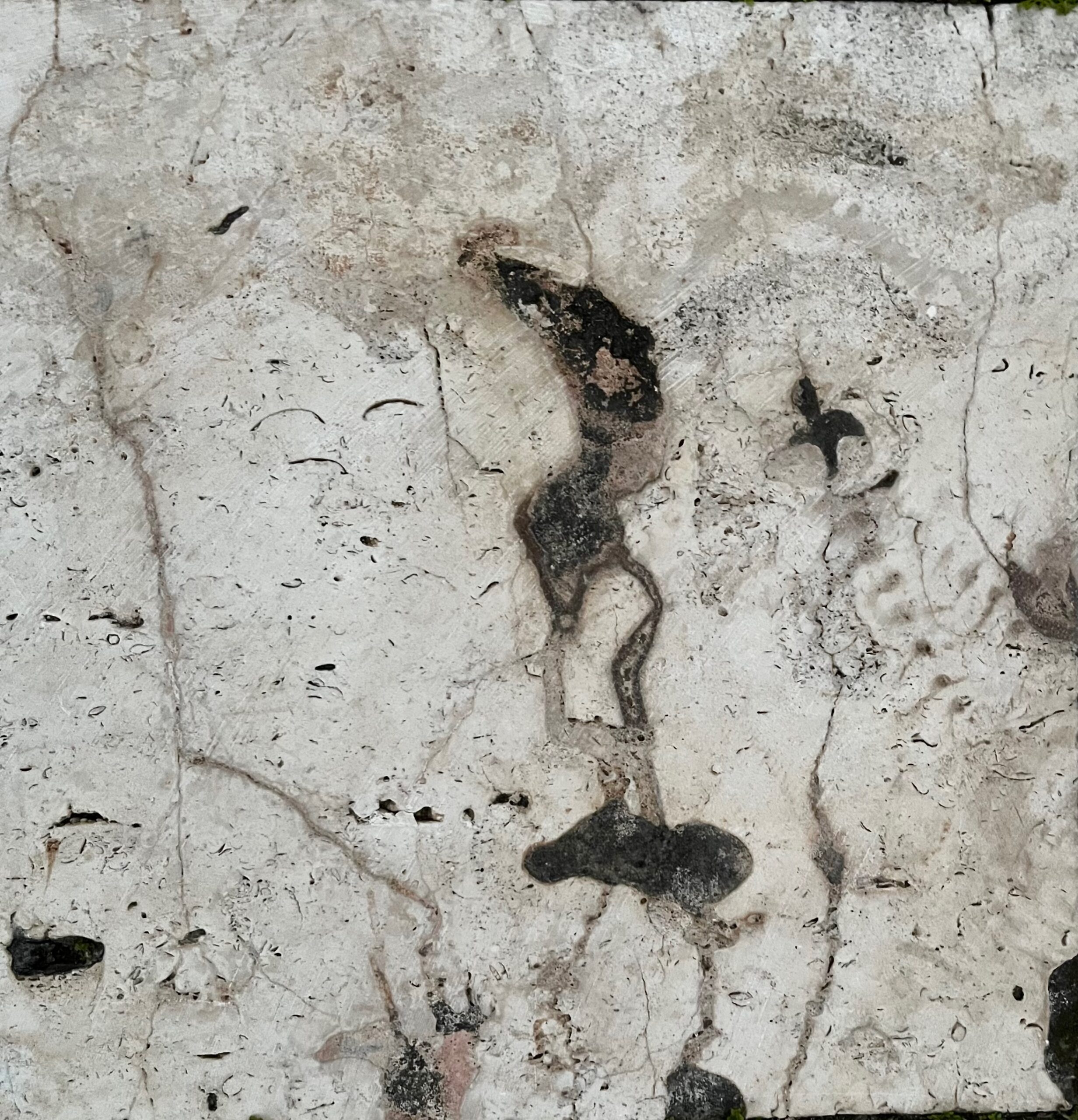 Sughra Raza. Found “Imaginary Being” (after Jorge Luis Borges). March 2025.
Sughra Raza. Found “Imaginary Being” (after Jorge Luis Borges). March 2025.
Digital photograph.
Enjoying the content on 3QD? Help keep us going by donating now.
Though we are an aggregator blog (providing links to content elsewhere) on all other days, on Mondays we have only original writing by our editors and guest columnists. Each of us writes on any subject we wish, and the length of articles generally varies between 1000 and 2500 words. Our writers are free to express their own opinions and we do not censor them in any way. Sometimes we agree with them and sometimes we don’t.Below you will find links to all our past Monday columns, in alphabetical order by last name of the author. Within each columnist’s listing, the entries are mostly in reverse-chronological order (most recent first).
 Sughra Raza. Found “Imaginary Being” (after Jorge Luis Borges). March 2025.
Sughra Raza. Found “Imaginary Being” (after Jorge Luis Borges). March 2025.
Digital photograph.
Enjoying the content on 3QD? Help keep us going by donating now.
by Malcolm Murray
By 2030, we will have countries of geniuses in data centers, but we won’t know what to do with them.

In my 10+ years as a Superforecaster, I have picked up many techniques and lessons regarding forecasting. Given the fractured state of the debate on Artificial General Intelligence (AGI) and AI progress, it seems useful to apply these Superforecaster lessons to the debate.
AI is a rich topic and of course contains many parallel debates, but one of the most heated (and most interesting) is regarding the expected continued speed of progress. That debate can probably be boiled down to the question of whether people are “feeling the AGI” or not. A phrase coined or at least popularized by Ilya Sutskever while at OpenAI, “feeling the AGI” has become a shorthand for a set of arguments saying that advanced AI will transform the world within a few years. This is the viewpoint of the people in the AI labs, for sure. See e.g. the statements from the leaders of the three leading AI labs – Sam Altman says “We are now confident we know how to build AGI”, Dario Amodei says “I think [powerful AI] could come as early as 2026”, and Demis Hassabis says “I think we’re probably three to five years away [from AGI]”. You can also find the frenzied AGI heads on X that greet every AI development with a collective genuflection of “AGI is near!”
In the other camp, you have the AGI naysayers, who for various reasons all believe that AI will not transform the world, or at least not in the near future, or without significant additional technological breakthroughs. Gary Marcus is a leading voice in this camp, other prominent members include Fei-Fei Li and Yann LeCun. The recent AI Paris Summit also showed that many politicians fall into this camp, from Macron seeing the summit as solely an investment opportunity to Vance’s speech downplaying any transformative effects AI might have.
We can try to make sense of this debate using some of the Superforecaster techniques and approaches. The first thing we need to do is to formulate the question more precisely. This is often one of the key reasons why people disagree, or debates get unresolved – a lack of precision in the question being discussed. This is very clearly the case with “feeling the AGI”. Read more »
by Gary Borjesson
Even if they had all the other good things, still no one would want to live without friends. —Aristotle
Is love an art? Then it requires knowledge and effort. —Erich Fromm

Many of us are, or soon will be, tempted to connect with an AI companion. Maybe you want a partner for your work or personal life. A friend of mine consults with a personal AI on his creative branding work for clients. A therapist or doctor can use a personal AI to help them track and reflect on specific patients. A recent article in the NYT describes a woman’s steamy (and expensive) romance with her AI boyfriend, Leo.
All of these and other possibilities are coming to pass. I take it for granted here that AIs are useful and pleasurable digital assistants or companions. With corporate powers making that case, the more pressing concern is to recognize the limits and dangers AI companions pose. This is urgent because AI companions exploit a human vulnerability: our resistance to the effort required for personal and interpersonal development.
I will focus on a fundamental limit overlooked by enthusiasts and critics of AI alike. A limit no tweaking of algorithms will overcome. A limit that makes AIs ontologically incapable of friendship. A limit that shows why we need to resist the considerable temptation to imagine AIs can be friends. To anticipate, consider two necessary conditions of friendship: that they are freely chosen, and mutual. We’ll see why AI companions cannot meet these conditions. But first let’s look at their basic limitation. Read more »
by Rafaël Newman
 This year marks the 80th anniversary of the end of the Third Reich, and thus of the industrialized mass murder known as the Holocaust, or Shoah—although 1945 was not the end, according to Timothy Snyder, of World War Two. That conflict, the historian maintains, was pursued by the otherwise victorious imperial powers in their respective independence-minded colonies, and only concluded with those powers’ defeat and withdrawal, or with the substitution of some variety of “post-colonial” economic system (The Commonwealth, La francophonie) for classic empire. To say nothing of the “mercantilist neo-imperialism” currently looming.
This year marks the 80th anniversary of the end of the Third Reich, and thus of the industrialized mass murder known as the Holocaust, or Shoah—although 1945 was not the end, according to Timothy Snyder, of World War Two. That conflict, the historian maintains, was pursued by the otherwise victorious imperial powers in their respective independence-minded colonies, and only concluded with those powers’ defeat and withdrawal, or with the substitution of some variety of “post-colonial” economic system (The Commonwealth, La francophonie) for classic empire. To say nothing of the “mercantilist neo-imperialism” currently looming.
In any case, eight decades after 1945, there are fewer and fewer survivors of the Nazi regime still alive—a recent publication, urgently entitled Bevor Erinnerung Geschichte wird (“Before memory becomes history,” 2022), contains interviews with a remaining handful of eyewitnesses to the Shoah. Today, with well-publicized settlements (or at least public investigations) of notorious thefts by the Third Reich such as those involving the “Nazi gold” transports, “dormant” bank accounts, and the Bührle Art Collection in Zurich, literary commemoration of the period has begun to turn from lived human suffering to what has been (or might have been) left to succeeding generations: to what has been materially bequeathed, in distinction from the traumatic psychological legacy of second and third-generation survivors. Increased attention is being paid to the physical estates of the victims of terror and genocide; to the belongings that were stolen from them, lost, or destroyed; to the property that individual members of targeted populations were obliged to leave behind, to sell for a pittance, or to have forcibly auctioned off. As if, having dealt comprehensively with the Third Reich’s violations of the Sixth Commandment—“Thou shalt not kill”—we have moved on to a reckoning with its infringements of the Eighth—“Thou shalt not steal.” Is any form of individual compensation, of making-good-again still possible, now that the physical and mental suffering of the victims has been largely acknowledged, their deaths publicly mourned? What would a literary performance of the acknowledgment of theft, and reparations for it, look like? Read more »
by Charles Siegel
We are barely two months into the second Trump administration, and already certain themes are beginning to feel stale. One of them is that “it’s impossible to keep up with everything.” “The jaw-dropping outrages just keep coming, day after day.” The idea that it’s all a deliberate effort to bludgeon us – political opponents, nonprofits, lawyers who represent political opponents or nonprofits, judges, us – into a feeling of helplessness and thus submission. Everything everywhere all at once. Even the feeling of being bludgeoned is beginning to curdle.
There are indeed outrages every day. But the main thing now happening every day is the wrecking of the federal government. Another few thousand federal workers are fired, or another federal agency is shuttered, all in the name of ending “waste, fraud, and abuse.” It’s virtually impossible now for any administration spokesperson to say anything without intoning these four magic words.
When the government, or DOGE, or some combination of the two began firing tens of thousands of “probationary” workers in February, White House spokeswoman Anna Kelly said that “President Trump is rooting out the vast waste, fraud and abuse across the Executive Branch. He will deliver on the American people’s mandate to effectively steward taxpayer dollars, which includes removing probationary employees who are not mission–critical.” On February 11th, with Elon Musk and his son looking on in the Oval Office, Trump said that “we” have already found “billions and billions of dollars in waste, fraud and abuse.” Even the Voice of America has gotten the treatment: the new director of the United States Agency for Global Media (which oversees VOA), Kari Lake, apparently appointed to oversee the near-total destruction of her own agency, stated last weekend that “waste, fraud and abuse run rampant in this agency and American taxpayers shouldn’t have to fund it.”
As mantras go, it’s undeniably an effective one. Who doesn’t want to eliminate wasteful spending? Or spending driven by fraudulent conduct? Or spending resulting from “abuse,” whatever that means exactly? And who doesn’t believe, or really just know in their bones, that “government” is inefficient, bureaucratic, sclerotic? Read more »
by David Kordahl

Twenty years after Steven Pinker argued that statistical generalizations fail at the individual level, our digital lives have become so thoroughly tracked that his defense of individuality faces a new crisis.
When I first picked up The Blank Slate: The Modern Denial of Human Nature (Steven Pinker, 2002), I was in my early twenties. The book was nearly a decade old, by then, but many of its arguments were new to me—arguments that, by now, I have seen thousands of times online, usually in much dumber forms.
In The Blank Slate, Pinker argued that humans are wired by evolution to make generalizations. These generalizations often lead us to recognize statistical differences among human subgroups—average variations between men and women, say, or among various races. Pinker showed that these population-level observations—these stereotypes—are often surprisingly accurate. This contradicted the widespread presumption at the time that stereotypes must be avoided mainly due to their inaccuracy. Instead, Pinker suggested that stereotypes often identify group tendencies correctly, but fail when applied to individuals. The argument against stereotyping, then, should be ethical rather than statistical, since any individual may happen not to mirror the groups that they represent.
Midway through reading The Blank Slate, I went to the theater to watch Up in the Air (2009), in which George Clooney portrayed a Gen-X corporate shark. At one point, Clooney advised his horrified Millennial coworker to follow Asians in lines at airports. “I’m like my mother,” he quipped. “I stereotype. It’s faster.”
This got a big laugh. We didn’t know, then, that Clooney—with his efficiently amoral approach to human sorting—represented our own algorithmic future.
Life in 2010 was still basically offline. But as members of my generation moved every aspect of our lives onto the servers, it became steadily easier to identify individuals by their various data tags. Dataclysm: Who We Are (When We Think No One’s Looking) (Christian Rudder, 2014) was assembled by one of the co-founders of the dating website OkCupid. It generalized wildly about differences among various racial groups, but no one could accuse the book of simple racism. Tech founders, after all, have large-number statistics to back up their claims—the very patterns that Pinker suggested were natural for humans to perceive, now amplified by enormous datasets and the sophisticated tools of data science. Read more »
by Hari Balasubramanian
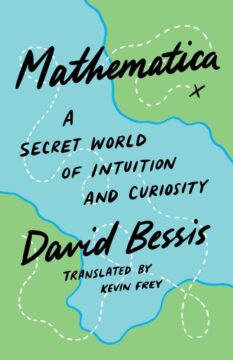
I’ve spent twenty-five years in a branch of applied mathematics called operations research; I’ve published papers and taught graduate engineering courses on probability, statistics, and optimization. But even with so much exposure to numbers and quantitative reasoning, I’ve never felt comfortable with math. That might sound like false modesty but it’s not: it’s the truth!
It’s been like this for as long as I can remember. In high school, I dreaded questions where different-colored marbles were drawn randomly from opaque jars. Derivatives and integrals in college courses were equally incomprehensible: I did them mechanically, through rote learning, not knowing why they were being calculated or what they meant. These days I am more familiar with notation, but it’s still not easy. Papers in my field are so crowded with sets and subsets, exponents and logarithms, theorems and lemmas, that I tend to give up very quickly.
My academic colleagues, friends, and some of my students, in contrast, seem far more comfortable. They walk through notation like they are reading prose and seem to grasp ideas much faster than I do. This leads to comical situations where I end up nodding sagely in meetings where somebody is explaining an algorithm or an equation, even when I am not getting it. This nodding reflex, I realize, hides certain fears: the fear of accepting to others how little one knows, or the fear of interrupting a conversation with too many naive clarifications.
Mathematica, a recent book by David Bessis (not to be confused with the software of the same name!), spoke directly to my experience. I finally understood why I feel the way I do. Bessis is a mathematician and I was a bit apprehensive about starting the book. But from the very first pages, I was drawn to his engaging and sincere tone. It felt like a conversation. Anyone, especially those who fear math, can draw solace and inspiration from the book. Indeed, the content is so unusual at times – there’s advice on how to remember one’s dreams, visualize the details of a room from a different vantage point (the ceiling, for instance), and discover our latent ability to echolocate – that it can feel quite tangential to its main theme. But that is precisely the point. Mathematics is not what it appears to be. Read more »
by Mark R. DeLong

Writing about American cars stranded in Fidel Castro’s Cuba, John McElroy observed that “there’s something very appealing, almost romantic about these cars. Coated in a patina of history they hearken back to a time when Detroit iron dominated the global auto industry, a time of can-do confidence when buyers were dazzled by toothy chrome grilles, bombsight hood ornaments and sweeping tail fins.” Although it is a bit painful to see the nostalgia about the glory days of the American auto industry in his prose, McElroy uses the word “patina” in exactly the way that car restorers use it. Patina goes beyond what it physically is—which is actually the rot—to include the way the rot got there and something of what the rotted thing represents. There is also something noble in the mix, some good breeding perhaps. Can a 1972 Ford Pinto acquire a patina? I know several classic car owners who would sniff at the thought, and yet, given the right cloud of memory, even a flammable Pinto could wax into someone’s well patina’ed example. Leave one in Cuba for fifty years and it might even cause an old guy’s heart to race. Patina, like love, may be fickle and very much dependent on sentiment and romance.
In the end, recovering the mix of the original and the present in a car under restoration means coming to terms with “patina,” and if you hear someone talk of a car’s patina, you have probably run into someone who is a practicing automotive archeologist, whether or not he or she knows it. To the restorer obsessed with the image of the car the “way it came off the line,” patina is an accumulation of unsavory rot, grease, fingerprints, soot, oxidized whatevers, and molecules of bird droppings. To such a person, a well patina’ed example is a polished turd, in a matter of speaking. But that is only half of the definition. To many restorers (and maybe even a growing number of them), patina truly is storied rot, which makes its grime and molecules something special. Read more »
Yet there is no country and no people, I think, who can look forward to the age of leisure and of abundance without a dread. For we have been trained too long to strive and not to enjoy. It is a fearful problem for the ordinary person, with no special talents, to occupy himself, especially if he no longer has roots in the soil or in custom or in the beloved conventions of a traditional society. –John Maynard Keynes
Remember the Sabbath day, to keep it holy. Six days you shall labor, and do all your work, but the seventh day is the Sabbath of the LORD your God. On it you shall not do any work […] For in six days the LORD made the heavens and the earth, the sea, and all that is in them, and rested on the seventh day. Therefore, the LORD blessed the Sabbath day and made it holy. –Exodus 20:8-11
Though it pains me to say it, I do not think the current AI revolution will go well. It’s not that I fear the Doom of humanity at the hands of rogue AI. I do not. What I fear, rather, is that the revolution will limp its way to apparent success under a regime where homo economicus continues to dominate policy and institutions. Under this ideology humans are economic agents acting in ways specified by game theory and economic growth the largest goal of society. Under the reign of homo economicus work has become a virtue unto itself, the purpose of life, rather than serving to support the pursuit of joy and happiness. The pursuit of happiness is but an empty phrase in an old ceremonial document.

That is the kind of world Kim Stanley Robinson depicted in his novel, New York 2140, which, as the title indicates, depicts the world as it might exist in 2140. That world has undergone climate change, and the seas have risen 50 feet – a figure Robinson acknowledges as extreme. Much of New York City, where the story is set, is now under water. Institutionally, it is very much like the current world of nation states, mega-corporations, and everything else, albeit looser and frayed around the edges. The rich are, if anything, even richer, but the poor don’t seem to be any worse off. The economic floor may in fact have been raised, as you would expect in world dominated by a belief in economic growth.
Technology is advanced in various ways, though not as flamboyantly as you might expect given current breathless hype about AI. Remember, the novel came out in 2017, well before ChatGPT (more or less) changed (how we thought about) everything. Still, Robinson did have an airship that was piloted by an autonomous AI that conversed with Amelia, its owner. He also had villages in the sky, skyscrapers much taller than currently exist in Manhattan, and skybridges connecting the upper stories of buildings whose lower floors were under water, where they are protected by self-healing materials.
So let us imagine that something like that world has come to pass in 2140. It’s not a utopia. But it’s livable. There’s room to move and grow.
As you may recall Robinson’s overall plot is modeled on the financial crisis of 2008. Some large banks become over-leveraged, and their impending failure threatens the entire banking system. In 2008 the banks were bailed out by the government. It went the other way after 2140. The banks were nationalized in 2143 and new taxes were passed. Consequently (pp. 602-603):
Universal health care, free public education through college, a living wage, guaranteed full employment, a year of mandatory national service, all these were not only made law, but funded. […] And as all this political enthusiasm and success caused a sharp rise in consumer confidence indexes, now a major influence on all market behavior, ironically enough, bull markets appeared all over the planet. This was intensely reassuring to a certain crowd, and given everything else that was happening, it was a group definitely in need of reassurance.
We are now almost at the end of New York 2140. Robinson’s left up to us to imagine how things worked out. That’s what I am doing here. Read more »
by David Winner

Unusual circumstances have given me an odd relationship with bodies, with nakedness. My father wouldn’t have been caught dead at a nude beach and would have been utterly perplexed if anyone described him as a nudist but tended to walk around the top floor of our Charlottesville home with his lower half exposed. Which only made me all the more modest about my own body until a coop lottery landed me in a nudist dorm at Oberlin College where suddenly boy and girl bodies were staring me in the face. Decades later, in my thirties, my friend, Louis Lucca, started driving me out to Jersey to the gay end of Sandy Hook’s nude beach where all sort of young, old, ugly, pretty physiques presented themselves to me.
But this writing is also about a very different body, a very old woman’s, that of my Great Aunt Dorle, who died in 2002 at 101.
I remember her old fashioned New York accent, right out of 1930’s movies. I remember the tiny grey hairs that peeked out from her upper lip, the few remaining teeth, the halitosis that was comforting in its familiarity, in its organic assurance that she was still with us. But I also recall her body. When those we love near the ends of their lives, sometimes we encounter their physical selves. My father’s was unfortunately already all too familiar, but I can’t forget his small, pale, wrinkled buttocks peering out from hospital gowns, nor my father-in-law’s thin haggard form in only underpants, and Dorle’s long, thin breasts springing like arms from her torso when I would undress her for bed.
When I was a child, Dorle was in her seventies and hardly seemed old. A publicist, a record producer, a thrower of enormous cocktail parties, she only seemed to age when her husband, Dario, died in 1980. Having recently been introduced to death – my two grandfathers and now Dario – I began to think that Dorle’s might be in the wings, but by the time of the memorial concert for Dario six months later, she’d rebounded, comforting a weeping Leonard Bernstein but back to being unflappable herself. Read more »
Plastic rose among a pile of assorted trash at the side of a road in Brixen, South Tyrol.
Enjoying the content on 3QD? Help keep us going by donating now.
by Akim Reinhardt
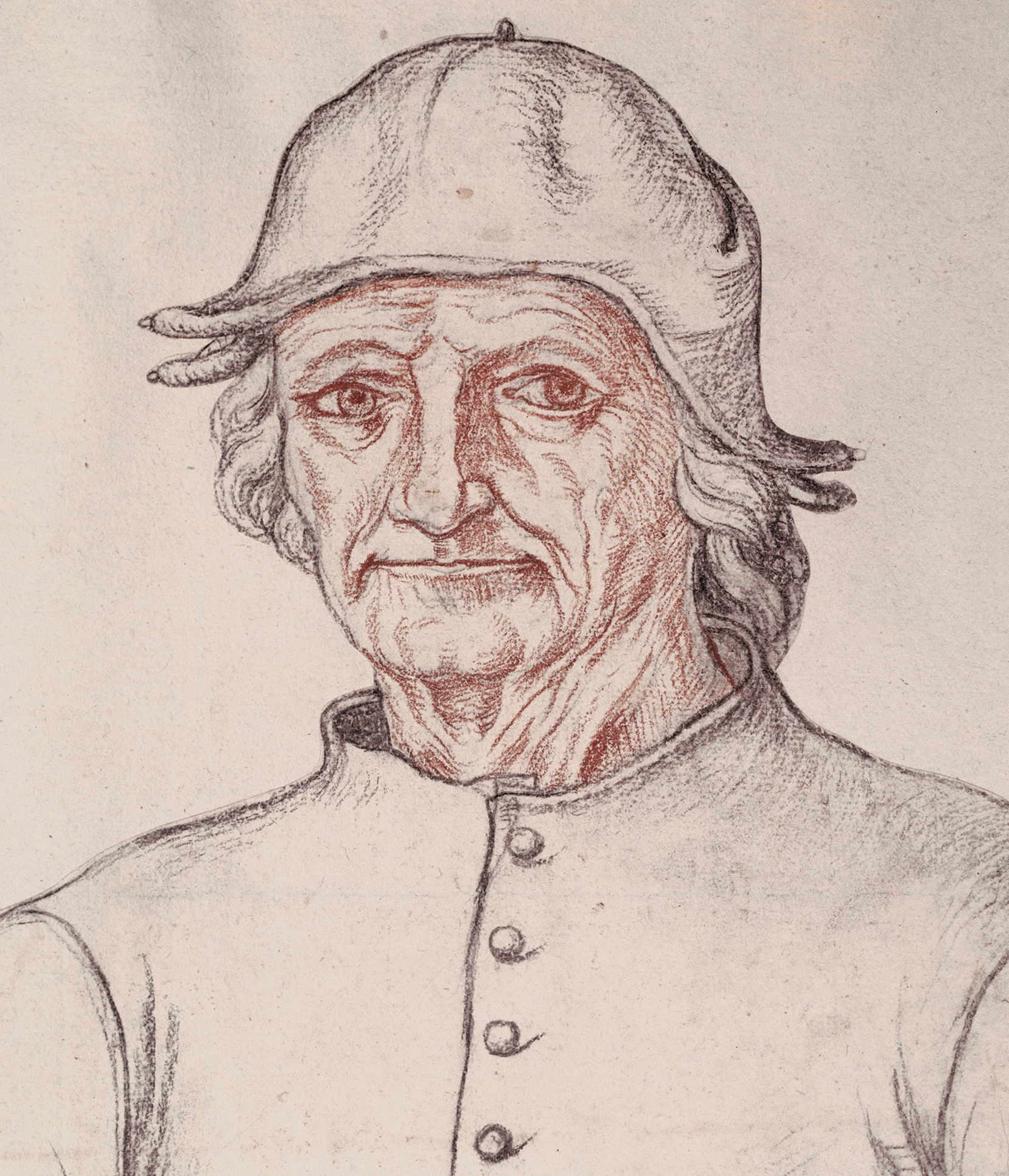
Medieval historians hate it, don’tcha know, when people talk about the Dark Ages. Scholars haven’t used the term in decades, eschewing it as an unfair and inaccurate description of 500–1000 years of European history, give or take. The Middle Ages weren’t just filth, poverty, violence, and ignorance, historians protest. They were actually a series of eras that featured the development of many knowledges and cultural innovations!
As someone who studies and teaches Native American history, I’m like: Hold my beer. You wanna talk about historical misperceptions unfairly miscasting regions and peoples as backwards, impoverished, and violent? You can’t even imagine. The Indigenous Americas featured numerous wealthy, art-laden empires. Large, orderly, planned Indigenous cities made even early modern European cities seem the filthy, disease-ridden, shambolic wreck by comparison. And all of it erased from popular historical memory so that in the aftermath of violent invasion, the colonial consciousness can be eased with lies about primitive savages.
But whether histories are erased and ignored, like those of Indigenous empires, or studied to the point of saturation, like much of European history, the truth is we can only imagine the past. We can never relive it. Even if it is recent and filmed, we can never be there, we can never participate. And even if we were there, even if we did participate and remember, memories aren’t as real as we think; they are reconstructions. Not merely subjective, memories are also limited and faulty.
And thus, the past always has at least one thing in common with the future. It must be imagined.
Was this time and place a dark age? Is a dark age coming? Look forward or back, we cannot know for sure. And anyway, what do we mean by “dark age.” Perhaps something about pervasive ignorance, the corruption of truth, and great difficulties in overcoming fallacies? Read more »
by Marie Snyder
Byung-Chul Han’s The Spirit of Hope is a beautiful book, the kind you want to treat with care and won’t dare dog-ear a page. Anselm Kiefer’s illustrations throughout provide a place for contemplative moments between ideas. It’s more immediately accessible than The Burnout Society, which took me weeks to wrap my head around, yet no less profound.
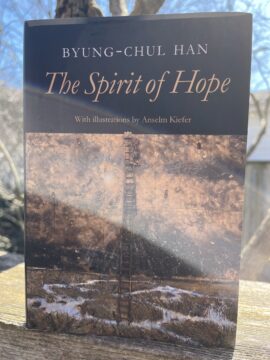
We like a secure illusion of control over the world, yet that hasn’t gotten us much further along. We recognize something’s missing. Han writes, “Amid problem-solving and crisis management, life withers. It becomes survival. … It is hope that opens up a meaningful horizon” (2).
Han explains how a lack of hope furthers the current neoliberal capitalist trajectory:
“Fear and resentment drive people into the arms of the right-wing populists. They breed hate. Solidarity, friendliness and empathy are eroded. … Democracy flourishes only in an atmosphere of reconciliation and dialogue. … Hope provides meaning and orientation. Fear, by contrast, stops us in our tracks. … Hope is eloquent. It narrates. Fear, by contrast, is incapable of speech, incapable of narration” (2-3).
Climate activist Roger Hallam recently wrote that the human race is likely going extinct this century, yet he demonstrates his hope in the very action of continuing to write our way through and by suggesting public alternatives to political capture. When we’re no longer open to seeing possibilities, we get held fast by fear, but it appears to be a feature of the system, not a bug.
“The current omnipresent fear is not really the effect of an ongoing catastrophe. … The neoliberal regime is a regime of fear. It isolates people by making them entrepreneurs of themselves. … Our relation to ourselves is also increasingly dominated by fear: fear of failing; fear of not living up to one’s own expectations; fear of not keeping up with the rest, or fear of being left behind. The ubiquity of fear is good for productivity. … To be free means to be free of compulsion. In the neo-liberal regime, however, freedom produces compulsion. These forms of compulsion are not external; they come from within. The compulsion to perform and the compulsion to optimize oneself are compulsions of freedom. Freedom and compulsion become one. … We optimize ourselves, exploit ourselves, to the bitter end, while harbouring the illusion that we are realizing ourselves. These inner compulsions intensify fear, and ultimately make us depressive. Self-creation is a form of self-exploitation that serves the purpose of increasing productivity” (9-10).
This brings to mind the many life hacks promoted to help self-automate our lives by creating habits to try to help us blow through chores and work without noticing it, as if to better sleepwalk through it all in a psychological version of Severance. As long as we’re optimizing ourselves, we’re not being; we’re merely objects that can work more efficiently, which further prevents our connection with others. Social media also paradoxically erodes social coherence, but “Hope is a counter-figure, even a counter-mood, to fear: rather than isolating us, it unites and forms communities” (10-11). Read more »
by Leanne Ogasawara
SURREALISM, n. Psychic automatism in its pure state, by which one proposes to express — verbally, by means of the written word, or in any other manner — the actual functioning of thought. Dictated by the thought, in the absence of any control exercised by reason, exempt from any aesthetic or moral concern. —André Breton

It’s 1923. And a student grabs a book off a shelf. Running for his life, book held tight, he is just one step ahead of a massive earthquake that would shake the world for four long minutes. Out of the building, he joins the surging crowds on the streets of Tokyo. People are in deep shock, but the young man is calm, reading as he walks among them. The book he grabbed was a novel by William Morris called News from Nowhere. It’s a work of socialist utopianism.
According to Shuzo Takiguchi, who is considered to be one of Japan’s great surrealistic poets, this experience was the start of his life as a poet. Disaster as the start of things. But despite what he claimed, we know that he’d already turned away from medicine, which his parents so desperately hoped he would study, instead spending more and more time in the university library reading literature.
And so, the Great Kanto Earthquake was not so much the inciting incident, as the event that let him off the hook.
As soon as the trains were running again, he returned to his family home in the countryside, where he tried to become a teacher. When this didn’t work, he was persuaded to return to university in 1925, and that was when he met the poet and classics scholar Junzaburō Nishiwaki, who was well-known at university for having studied at Oxford. Together with a group of other poets, they founded a literary journal devoted to French surrealism, which by that time had become Japan’s most popular avant-garde movement. Read more »
by Eric Feigenbaum

In 1965, Singapore’s Founding Prime Minister, Lee Kuan Yew corrected an Australian news reporter:
“I am not in fact Chinese. I am Malaysian. I am by race Chinese. I am no more Chinese than you are an Englishman.” He refined the example on other occasions, eventually saying he was “no more Chinese than President Kennedy was an Irishman”.
Like his examples, Lee grew up speaking English – it was a first language for him along with Malay.

In those days, it was far from clear English would continue as a dominant language in the countries spun out of British Malaya, let alone that it would later create an unexpected cascade of successes for Singapore.
One of the pressing issues of Singapore’s early days was the cultural tension related to choosing the fledgling country’s language. The 500 square kilometer island was nearly empty when the British claimed it in the 1820’s, turning it into an open-port city with a very loose immigration policy. When considering the issue in 1965, few if any imagined their choice of language could become an economic asset of untold dimensions.
Even prior to Singapore’s inception, the question of a national language among the major three ethnicities – Chinese, Malay and Tamil Indian – was charged. It highlighted just how much Singapore was a land of immigrants – migrants really – who left their home countries in search of work and opportunity. There was no “Singaporean” ethnicity – just a collection of people who called Singapore home.
Much agonizing led to the Singaporean version of the Connecticut Compromise. Singapore would make Mandarin, Malay, Tamil and English all official, legal languages that could be used in court or on legal documents. Yet it would also make English – the language of no one ethnicity – the working and educational language of Singapore. One common tongue everyone could share. Read more »
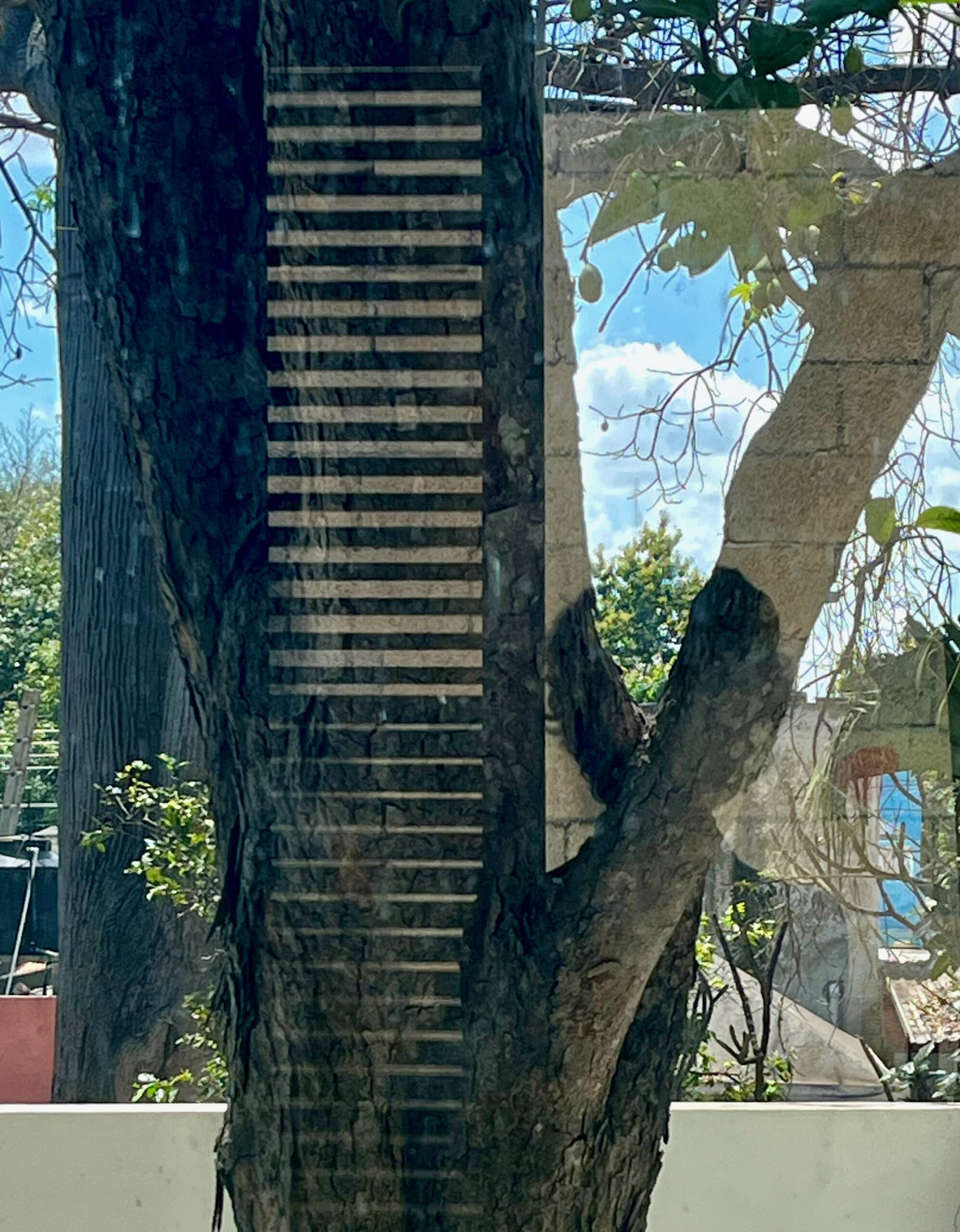 Sughra Raza. Self portrait with Shutter and Tree, Merida, March 2025.
Sughra Raza. Self portrait with Shutter and Tree, Merida, March 2025.
Digital photograph.
Enjoying the content on 3QD? Help keep us going by donating now.
by Michael Liss
It is more proper that law should govern than any one of the citizens. —Aristotle, Politics

Aristotle was an optimist. Try to visualize an old Greek guy in a himation as a talking head on one of the Sunday shows. He’s never getting an invite to the White House—and it’s not just because of the clothes. Limits on an American President? This American President?
It is grim out there if you are a Democrat. The House, gone; Senate, gone; White House, so far away the distance is measured in light years. SCOTUS, nauseatingly gone. Day after day, Trump, with the cunning of an outlaw biker President, uses his power to taunt, punish and utterly dominate anyone who had or has the temerity to oppose him. Based on the number of prominent people and institutions that have knelt before him, he’s darn good at it. He’s also darn good at speaking to his supporters, and particularly skilled at keeping his fellow Republicans in line. Trump speaks fluent Trump, and Republicans, increasingly, are learning repeatable, debate-ready whole paragraphs of Trumpiness to be used in almost any circumstance. It’s a “Newspeak” modernized from 1984, and it works. People understand it. They react to it viscerally.
How about Democrats? With some notable exceptions, they mostly speak Esperanto. Excellent at cocktail parties with your photos of the Prado (“The Goyas were amazing!”), but not all that useful for everyday conversation.
Full stop. I am not going on an extended “TDS” rant, or its post-November 2024 variant of perpetual Democratic self-flagellation. Newspeak is also a definite no. Let’s talk about power in our system, the extent and implications of it, how it’s expressed and constrained, and the political application of it. In short, let’s channel our inner Aristotle and survey the role of the Rule of Law in contemporary politics.
Perhaps it is best to state the obvious at the beginning: What role? The Rule of Law is a losing argument in recent elections—and it is a losing argument to make to politicians. Maybe that will change, maybe it’s a temporary phenomenon of the Trump Era, maybe it just lacks a compelling spokesperson, but many voters don’t care—and in fact, some cheer its failure.
What is it they are rejecting? What is the Rule of Law? Read more »
by R. Passov

There’s a small, interesting book store in NYC, small enough for a pixie-of-a-lady and about 200, mostly rare, mostly old, and almost exclusively, cookbooks. The store is near my favorite bar and that’s all I’m going to say.
I first wandered into that shop while trying to walk off a handful of afternoon beers (at that favorite bar). I’ve since gone back many times, usually in search of quirky presents such as a picture book, made in the late 1970’s that contains a replica of every label for every bottle of Italian wine that had been offered in the prior one hundred years – exactly what to get an Italian friend who makes his own pasta and wine. For another close friend I procured a first edition of Diet and Reform by M K Gahndi, perfectly fitting in my view as I had come to believe that close friend was in need of both.
But this essay is not about that bookstore or the nearby bar nor the books in that store that I have found for others. This essay is about a rambling discourse, written as WWII approached its last summer, written mostly in Culoz, France, a small town much closer to Switzerland than to Paris, where Gertrude Stein and Alice B Toklas spent the last years of WWII.
Stein’s book, Wars I have Seen, is a repetitive reflection on living in the foothills during the waining days of the war. The French were emerging from one regret – that of having lived meekly under the dominion of the Germans – into another. They had allowed for their own subjugation by such a meek foe, as though the shame was not in having been conquered but rather that the conquerors turned out not to be all that.
I knew nothing about Wars I Have Seen. What caught my attention was first its cover – a distinctive jacket design by Cecil Beaton – and next that, unlike almost all other books in that shop, it was not a cookbook. Read more »
I sometimes shudder at old pics,
their bittersweetness, their
cutting edge, their tricks:
….. daughter’s brilliant smiles,
….. mittens hung from cuffs,
….. Kodachrome taunts of time
….. —enough
I’d rather mine old stones, turn up
what’s scattered within my heart and head
….. —the gold
I’d rather stick with what’s been deeply sown,
take joy in what, within my heart, has grown.
I do not like as much, nostalgic risks.
The photo box stays beneath the bed
with CDs and snaps of bygone’s code
on paper, or on disks.
….. When memory goes will it matter?
Then, I may not even recognize the
aliens who peer from three by fours
or smile from screens in pixel splatters.
Love is as it comes in time, as it is in
moments real. Now is breath’s agency.
Now is never still, but alive, not held
in poignant frozen shots—
….. is immediate
….. is not mere blur
….. is true
….. sublime
Jim Culleny
Jan 29, 2011_Rev_032125
Enjoying the content on 3QD? Help keep us going by donating now.